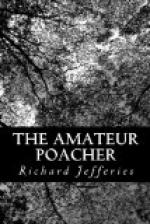WOODLAND TWILIGHT: TRAITORS ON THE GIBBET
In a hedge that joined a wood, and about a hundred yards from it, there was a pleasant hiding-place beside a pollard ash. The bank was hollow with rabbit-buries: the summer heat had hardened the clay of the mound and caused it to crack and crumble wherever their excavations left a precipitous edge. Some way up the trunk of the tree an immense flat fungus projected, roughly resembling the protruding lip of a savage enlarged by the insertion of a piece of wood. If formed a black ledge standing out seven or eight inches, two or three inches thick, and extending for a foot or more round the bark. The pollard, indeed, was dead inside, and near the ground the black touch-wood showed. Ash timber must become rarer year by year: for, being so useful, it is constantly cut down, while few new saplings are planted or encouraged to become trees.
In front a tangled mass of bramble arched over the dry ditch; it was possible to see some distance down the bank, for nothing grew on the top itself, the bushes all rising from either side—a peculiarity of clay mounds. This narrow space was a favourite promenade of the rabbits; they usually came out there for a few minutes first, looking about before venturing forth into the meadows. Except a little moss, scarcely any vegetation other than underwood clothed the bare hard soil of the mound; and for this reason every tiny aperture that suited their purpose was occupied by wasps.
They much prefer a clear space about the entrance to their nests, affording an unencumbered passage: there were two nests within a few yards of the ash. Though so generally dreaded, wasps are really inoffensive insects, never attacking unless previously buffeted. You may sit close to a wasps’ nest for hours, and, if you keep still, receive no injury. Humble-bees, too, congregate in special localities: along one hedge half a dozen nests may be found, while other fields are searched for them in vain.
The best time to enter such a hiding-place is a little before the sun sinks: for as his beams turn red all the creatures that rest during the day begin to stir. Then the hares start down from the uplands and appear on the short stubble, where the level rays throw exaggerated shadows behind them. When six or eight hares are thus seen near the centre of a single field, they and their shadows seem to take possession of and occupy it.
Pheasants, though they retire to roost on the trees, often before rising come forth into the meadows adjacent to the coverts. The sward in front of the pollard ash sloped upwards gradually to the foot of a low hill planted with firs, and just outside these about half a dozen pheasants regularly appeared in the early evening. As the sun sank below the hill, and the shadow of the great beeches some distance away began to extend into the mead, they went back one by one into the firs. There they were nearly




